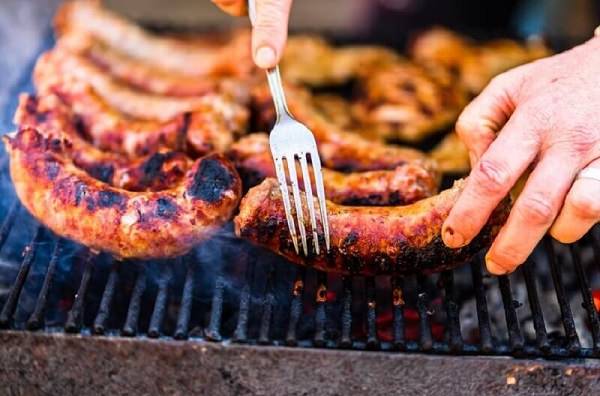Welcome to the world of Kransky, where culinary simplicity meets mouthwatering delight! Originating from Slovenia, Kransky sausages offer a burst of unique flavors that can transform your kitchen into a haven of savory goodness. Whether you’re a fan of the traditional pork blend or intrigued by the cheesy variation, cooking Kransky is an artful yet straightforward endeavor. With easy-to-follow methods such as boiling, baking, or grilling, you can unlock a symphony of tastes that has captivated taste buds worldwide. So, dust off your frying pan, gather the essentials, and let’s dive into the delicious journey of cooking Kransky – a culinary adventure that promises joy in every bite!
What is Kransky?
Kransky, also known as Kranjska klobasa or Carniolan sausage, is a Slovenian sausage that dates back to the 19th century. This hot-smoked pork sausage is seasoned with black pepper and garlic, creating a distinctive taste that has captured the palates of people worldwide.
Ingredients for Cheese Kransky
While the traditional recipe includes pork, bacon, garlic, salt, and pepper, the cheese Kransky introduces a delightful twist by incorporating small chunks of hard cheese. This variation adds an extra layer of richness and complexity to the flavor, making it a favorite among sausage enthusiasts – especially in Australia. Not the forget, cheesy kransky are Aussie’s favorite!
Cooking Techniques for Sausages
The versatility of sausages allows for a range of cooking techniques, including stove-top cooking, grilling, baking, pressure cooking, crockpot simmering, air frying, and frying pan methods. Each method offers a unique texture and flavor profile, catering to diverse culinary preferences.

Methods of Cooking Kransky
Kransky sausages, recognized and protected by the European Commission, are a treat that comes to life through various cooking methods. Here’s how you can cook them up for a delicious experience:
Boiling
- Fill up a pot with water and a touch of oil.
- Let the Kransky sausages take a gentle dip in the boiling water.
- In about 8-10 minutes, you’ll have sausages cooked to perfection, meeting the 160°F mark for safety.
Baking
- Preheat your oven to a toasty 180°C (200°F).
- Lay out the Kransky sausages on a tray lined with parchment paper.
- Bake for around 30 minutes until they achieve that golden, crispy goodness.
Grilling
- Fire up the barbecue or chargrill pan to high heat.
- Add a splash of oil and let the Kransky sausages dance on the grill.
- Flip them every so often for about 8-10 minutes until you get that perfect golden exterior.
Each method brings its own charm to the Kransky experience. Whether you prefer the comforting soak of boiling, the aromatic embrace of baking, or the sizzle and sear of grilling, you’re in for a flavor-packed adventure. And remember, hitting that 160°F internal temperature is the secret to both a safe and mouthwatering result.
Tools and Ingredients
To embark on the journey of cooking Kransky, you’ll need a few essential tools: a frying pan and tongs.
Ingredients for a basic Kransky recipe include:
- Traditional or cheese Kransky sausages
- Almond oil
- Burger buns
- Coleslaw
- Dijon mustard
Recipe for Kransky
- Score each Kransky with three cuts to enhance the flavor infusion.
- Heat 1 tablespoon of olive oil in a large frying pan over medium-high heat.
- Fry the Kransky for 8-10 minutes, turning often, until golden and thoroughly cooked.
- Serve the Kransky on hot dog buns with a side of coleslaw and a generous drizzle of Dijon mustard.

Nutritional Information
Per 100 grams, Kransky sausages provide 219 calories, 17.7 grams of fat, and 15.4 grams of protein, with a notable sodium content. Cheese Kransky may have a higher fat content (20.3 grams) and slightly lower protein (14.9 grams), offering a richer and creamier experience.
Serving Suggestions and Pairings
Traditionally, Kransky sausages are enjoyed hot on white bread with mustard and horseradish. They pair exceptionally well with acidic turnips or cabbage, adding a delightful contrast to the savory and smoky notes. Kransky can also be used to enhance salads, and sandwiches, or mixed with various vegetables for added depth.
Kransky in Australia
In Australia, Kransky has become a culinary sensation, embraced for its unique taste and versatility. Its popularity has soared, making it readily available across the country. Australians have incorporated Kransky into their cuisine, experimenting with different cooking styles and innovative serving ideas.
What do Aussies Call Sausages?
In the land Down Under, sausages are affectionately referred to as “snags.” This colloquial term reflects the friendly and laid-back Australian culture, where a barbecue (BBQ) is incomplete without sizzling snags. Aussies take pride in their sausage traditions, often enjoying them at gatherings, family events, and weekend barbecues.

Comparison with Chorizo
While Kransky and chorizo both fall under the category of sausages, they differ in serving style, spiciness, and preparation. Chorizo, typically diced and fried, is known for its spiciness derived from paprika, garlic, salt, and chili. Kransky, on the other hand, is hot-smoked, requiring additional preparation. It is often served whole, highlighting its unique flavor without the need for added spices.
Conclusion
And there you have it – the delightful journey of cooking Kransky! Whether you fancy the classic or the cheesy version, the easy methods like boiling, baking, or grilling bring out the best in these sausages. Australians, in particular, have embraced Kransky, making it a star in barbecues.
So, gather your tools, try out the simple recipe, and enjoy the unique flavors. In the land Down Under, they affectionately call sausages “snags,” and Kransky has found its place in this friendly tradition. Embrace the joy of Kransky cooking – it’s an Aussie favorite and a global sensation!




